I'd like to create a small circuit that I can use to power my headphones off a USB port's 5V to avoid having to deal with AAA batteries (even rechargeable batteries can get lost, etc.). To do this, I need to know how much current I can expect my circuit to deal with to be within the specification that the headphones are made against, so I tried to find the maximum peak and sustained current of a AAA battery, and, to my surprise, I was unable to find it either here or on another website. What currents should I design my circuit to handle?
-
You will want to read this for a starting point on this project: https://electronics.stackexchange.com/q/34745/2028 – JYelton Oct 20 '21 at 23:51
-
How many AAA's ? – Tony Stewart EE75 Oct 21 '21 at 00:10
-
Depends on the brand. Get a datasheet for your specific battery. – Hearth Oct 21 '21 at 00:11
-
AAA specifies a physical size of the cell, not its capacity to supply current – jsotola Oct 21 '21 at 00:33
-
@jsotola how do designers of consumer electronics who must accept a AAA battery (or more than one) know how much current they can safely and reliably draw? Lots of consumer electronics seem to be designed to take any AAA battery as is sold in stores. – john01dav Oct 22 '21 at 01:07
-
Related answers at: [How many amperes can an alkaline AA battery supply?](https://electronics.stackexchange.com/q/571226/39511) – feetwet Mar 22 '23 at 19:36
4 Answers
The max current of a standard AAA alkaline battery is... a few amps. At dead short. It does not last long. This is not a standard use, basically destructive, and is not tested for.
A standard rating of 1 amp draw is normally 1 hour or less. This is the far end of usable and you can find this on the Current vs Capacity or Lifespan graph on the datasheet for the battery you have. If it's very cheap you may not find one, so Google energizer AA alkaline datasheet. This will be a baseline "good" battery for your reference.
But its safe to say that your use case is not amps or even 1 amp unless your headphones only last 1 hour. It's probably a much lower 500 to 100 or even less mA draw.
- 72,580
- 7
- 90
- 202
I gather your headphones use AAA batteries, which means they operate/expect some multiple of 1.5 volts (for alkaline cells).
Your question is somewhat based on a false premise of worrying about the current that batteries supply versus a USB port. Instead you should be concerned with voltage. The load (your headphones) will draw whatever current they require at the moment, which will vary depending on what they are doing.
Power supplies and batteries (voltage sources) will try to maintain a given voltage, and the load will "pull" whatever current it needs. If the pull exceeds that of the voltage source, the voltage will drop (also called "droop" or "sag" etc.). Some power supplies, like a USB port, may shut off as a precaution, also known as "over current protection."
My suggestions for you are:
- Determine the voltage the headphones operate on. If they use two alkaline AAA cells, then the voltage is 3.0 V.
- Research how to drop/buck the 5 volts from USB to the required voltage. I wrote a Q&A on this here.
- Consider that by powering the headphones from a USB port, they will presumably become wired instead of wireless (I'm guessing they are wireless if they take batteries).
Once you've done this, post a new question that asks about a specific aspect of what you are attempting to accomplish. Hope that helps!
- 32,302
- 33
- 134
- 249
-
^^^ This. What the batteries can do is irrelevant. It's what your LOAD does that matters. Your car battery can put out 600A. When you turn your radio on, does it consume 600A? Nope. The load controls the current, not the source. Very very common misconception when starting out in electronics. – Kyle B Oct 21 '21 at 03:36
-
@KyleB your car battery will put out way more than 600A in a dead short – Tiger Guy Oct 21 '21 at 18:03
-
2@TigerGuy Not sure why you felt you needed to say that when obviously I was just throwing a typical number out there for comparisons sake, not to be taken literally but OK. Thanks I guess... – Kyle B Oct 21 '21 at 19:16
-
-
1@Tiger You are still missing the point. Kyle was showing that despite a car battery being capable of 600+ A, a device like a car stereo does not utilize or pull that much. – JYelton Oct 21 '21 at 20:00
-
-
@Tiger You must be trolling at this point. The comment here was not meant to answer the question, but provide additional examples and context. You can stop now. – JYelton Oct 21 '21 at 20:31
-
-
@JYelton Thx man. Don't sweat it. I know why he did that, some folks feel the urge to prove how smart and knowledgeable they are at every opportunity. He hasn't been at this site long enough to realize just about EVERYBODY hanging here is pretty darn smart & knowledgeable. I've been a degreed EE for >25 years and been a shadetree mechanic for >30. It's extremely unlikely he's very far ahead of me in my understanding of "how cars work". So Imma certainly not let it bother me.... – Kyle B Oct 21 '21 at 21:18
-
I understand the general method I need (my headphones use 1.5V and I know how I want to do the conversion from the 5V source that USB provides), but when I create the votage-dropping circuit (or, much more likely and sensibly, string together a few commercial ICs to do it) I need to know how much current I need to ensure that said circuit can handle -- hence the question. – john01dav Oct 22 '21 at 01:04
-
@tiger the question may ask about max but it's not about absolute max, it's really about situational max. You have to read between lines sometimes. – Passerby Oct 22 '21 at 02:09
-
@john01dav Your most likely options would be a linear regulator (like an ADP3338 if you can use a surface mount regulator), or a DC-DC buck converter. The current draw should be of minimal concern: A common USB 2.0 port supplies ~500mA at 5V. Even after inefficiencies due to conversion, you should well be within the port's supply capability. – JYelton Oct 22 '21 at 02:43
Procell AAA ALKALINE-MANGANESE DIOXIDE BATTERY 1200 mAh <=29 mA for 34h with load = 43 Ohms from 1.5 to 0.8V or you could same 1200 mAh/20h = 60 mA or much shorter durations with higher than suggested load currents.
Lesser than these professional AAA cells will not last as long.
If you headphone amplifier can be kept on float charge with 5V USB using a 3 terminal FET LDO, then your battery life on float voltage will last much longer and not drain much power from the USB 10W or 12W charger if the amplifier is say 1W per channel.
- 1
- 3
- 54
- 182
Your headphones probably don't use much power. I would say that you should design your circuit to supply 100 mA. I can't imagine headphones needing more than 100 mA. AAA batteries can supply 100 mA or maybe 500 mA. At higher currents they just drain too fast and are not practical.
- 28,915
- 1
- 28
- 81

